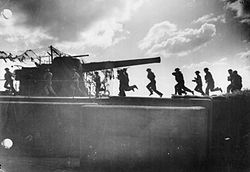Culver Battery
| Culver Battery | |
|---|---|
| Culver Down, Isle of Wight, England | |

A crew from 118th Battery ready one of the two 9.2 inch gun coastal defence guns for action at Culver Point Battery, August 1940
|
|
| Coordinates | 50°39′58″N 1°05′53″W / 50.666128°N 1.097917°W |
| Site information | |
| Controlled by | National Trust |
| Open to the public |
Yes |
| Condition | Ruined |
| Site history | |
| Built | 21 July 1906 |
| Built by | British Army |
| Materials | Concrete |
| Demolished | 1956 |
| Events |
First World War Second World War |
| Garrison information | |
| Garrison | 527th Coast Regiment |
Culver Battery is a former coastal artillery battery on Culver Down, on the eastern side of the Isle of Wight. The fortification is one of several Palmerston Forts built on the island following concerns about the size and strength of the French Navy in the late 19th century. It was operational during the First and Second World Wars. The battery was closed in 1956.
A battery on the eastern cliff of Culver Down was first proposed in 1887. Its purpose was to stop enemy ships firing unopposed at the pre-existing batteries at Yaverland and Redcliff. The new fortification would be armed with three 6-inch breachloaders with two QF 6-pounder Hotchkiss in support. The guns would all be fitted on hydraulically operated disappearing mounts. However, by 1889, even though the battery had still not been built, the War Office had decided the Hotchkiss would be replaced with 4.7-inch guns.
The delay in construction was caused by a disagreement at the War Office between the Inspector-General of Fortifications and the Director of Artillery over the installation of disappearing mounts. Objections were raised over their necessity because Culver Down is atop a cliff, 300 ft (91 m) above the shoreline. The row led to further delay as the funding for the military project was no longer available.
The battery was eventually built between 3 May 1904 and 21 July 1906. The two main gun emplacements, which were built from brick and reinforced concrete, each had a fixed barbette that housed a 9.2-inch Mk X gun. A report in 1906 by the Royal Engineers stated:
...
Wikipedia

